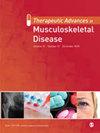Minodronate for severe multiple vertebral fractures due to pregnancy- and lactation-associated osteoporosis: a case report and literature review
IF 3.4
2区 医学
Q2 RHEUMATOLOGY
引用次数: 0
Abstract
Pregnancy- and lactation-associated osteoporosis (PLO) is a rare type of premenopausal osteoporosis, typically occurring during the third trimester of pregnancy and the early postpartum lactation period. This report presents a case involving severe multiple vertebral fractures due to PLO with low bone mineral density (BMD) and heightened bone turnover. A 39-year-old primiparous Japanese woman reported low back pain (LBP) starting at 28 weeks of pregnancy. The pain temporarily improved after delivery, although the LBP recurred and worsened 2 months into breastfeeding. Thereafter, the patient visited the Obstetrics and Orthopedic departments. Plain radiographs of the thoracic and lumbar spine showed loss of vertebral body height at the T4–12 and L1–3,5 vertebrae, leading to a diagnosis of 13 fractured vertebrae. BMD and serum bone turnover markers revealed low bone density and heightened bone turnover. In the absence of any identified alternative cause of secondary osteoporosis, the diagnosis was severe PLO with 13 vertebral fractures related to pregnancy and lactation. After treatment with bisphosphonates and an active vitamin D analog, the patient exhibited an increased BMD and normalization of bone turnover and resumed regular daily activities. Although the optimal PLO treatment strategy remains uncertain, bisphosphonates are an option; however, bisphosphonates can potentially affect the fetus through placental transfer. Therefore, careful consideration is required for patients planning pregnancy. Despite bisphosphonates’ widespread use and cost-effectiveness, selecting PLO medications involves multiple factors, necessitating further research.米诺膦酸钠治疗妊娠和哺乳期相关性骨质疏松症导致的严重多发性椎体骨折:病例报告和文献综述
妊娠和哺乳期相关性骨质疏松症(PLO)是一种罕见的绝经前骨质疏松症,通常发生在妊娠期的第三个月和产后哺乳早期。本报告介绍了一例严重的多发性椎体骨折病例,其病因是 PLO 引起的低骨矿密度(BMD)和骨转换率增高。一名 39 岁的日本初产妇在怀孕 28 周时开始出现腰背痛(LBP)。分娩后疼痛暂时好转,但在哺乳期两个月后腰痛复发并加重。此后,患者前往产科和骨科就诊。胸椎和腰椎的平片显示,T4-12和L1-3,5椎体的椎体高度降低,因此诊断为13椎体骨折。骨密度和血清骨转换标志物显示骨密度低,骨转换增加。由于没有找到继发性骨质疏松症的其他病因,诊断结果为重度 PLO,13 处椎体骨折与妊娠和哺乳有关。在接受双膦酸盐和活性维生素 D 类似物治疗后,患者的 BMD 有所提高,骨转换恢复正常,并恢复了正常的日常活动。尽管最佳的 PLO 治疗策略仍不确定,但双膦酸盐是一种选择;然而,双膦酸盐有可能通过胎盘转移影响胎儿。因此,计划怀孕的患者需要慎重考虑。尽管双膦酸盐被广泛使用且具有成本效益,但 PLO 药物的选择涉及多种因素,需要进一步研究。
本文章由计算机程序翻译,如有差异,请以英文原文为准。
求助全文
约1分钟内获得全文
求助全文
来源期刊

Therapeutic Advances in Musculoskeletal Disease
Medicine-Rheumatology
CiteScore
6.80
自引率
4.80%
发文量
132
审稿时长
18 weeks
期刊介绍:
Therapeutic Advances in Musculoskeletal Disease delivers the highest quality peer-reviewed articles, reviews, and scholarly comment on pioneering efforts and innovative studies across all areas of musculoskeletal disease.
 求助内容:
求助内容: 应助结果提醒方式:
应助结果提醒方式:


